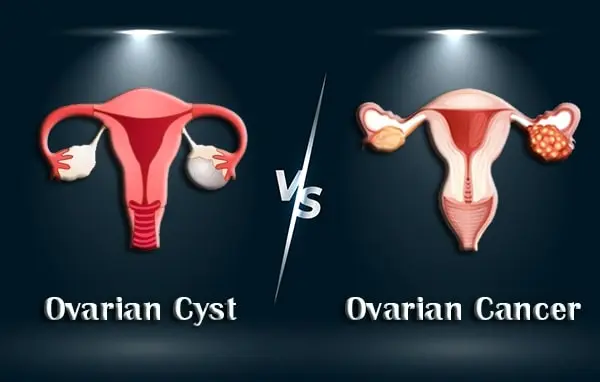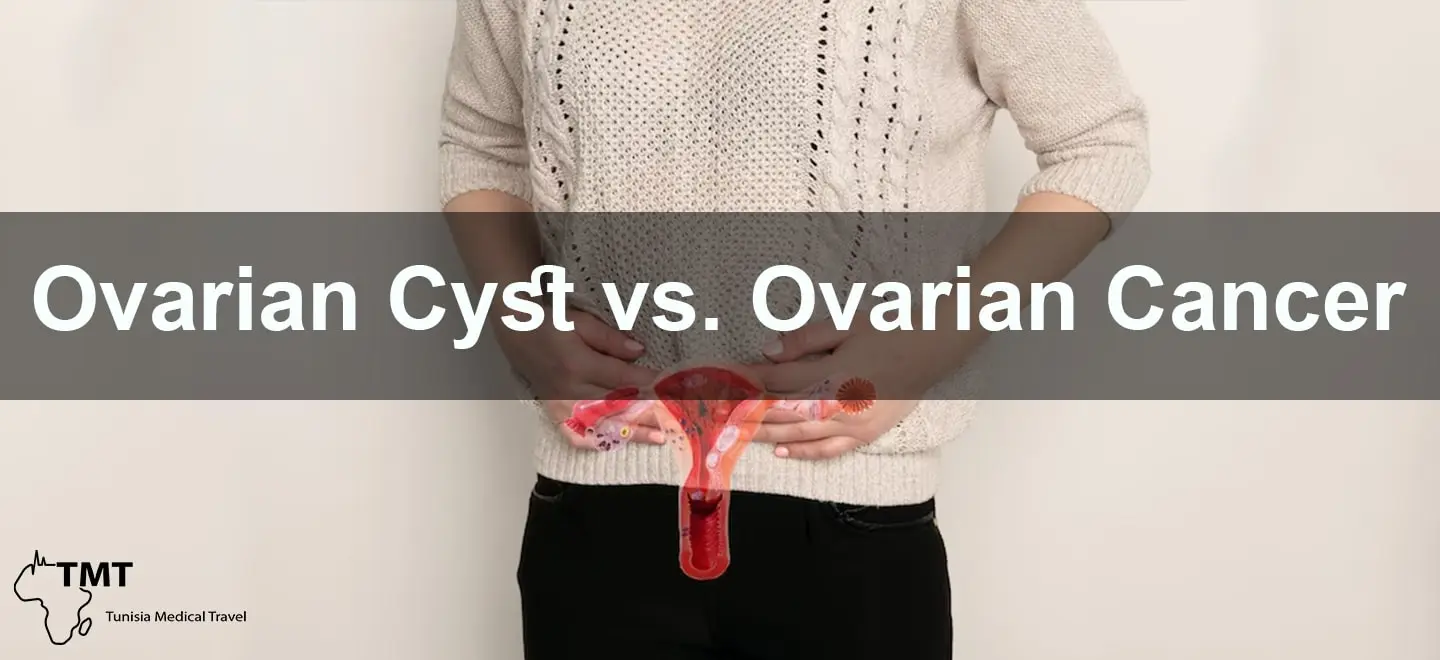Ovarian Cyst vs. Ovarian Cancer
Ovarian Cyst vs. Ovarian Cancer
What Are Ovarian Cysts?
By definition, a cyst is a fluid-filled sac. « Cyst » is derived from the Greek word « kystis » which means « bladder » and the Latin « cista » meaning « box » or « basket. » There are various types of cysts. In the ovaries, there are two types of cysts: functional and complex. A functional cyst is the most common and is often formed during the menstrual cycle. These cysts occur when either the egg is not released, or the follicle that releases the egg does not dissolve after the egg is released. In both cases, the sac that the egg is contained in becomes a cyst. This is not to be alarmed about, as 3 out of every 4 women will experience the formation of functional cysts at one point in their lives and often go undetected, resolving on their own. What are ovarian cysts? Most simply stated, an ovarian cyst is a tiny sac filled with fluid that forms on or within the ovary. Cysts can range widely in size, from as small as a pea to larger than an orange. A cyst can be found in one or both ovaries. Depending upon the type of cyst, it can dissolve on its own, or in some cases, may require surgical removal.
What Is Ovarian Cancer?
Ovarian cancer is a growth of abnormal malignant cells that begins in the ovaries (women’s reproductive glands that produce ova). Cancerous (malignant) ovarian tumors begin in the ovaries and can spread to the pelvis and abdomen. The cancer can also spread to the lymph nodes and other areas apart from the lungs and liver. Tumors in the ovaries can be benign (not cancer) or malignant (cancer). These can also spread in the female reproductive system. The two types of tumors are named after the kind of cells they are made up of. Ovarian cancers are the 7th most common cancer in women around the world. They are most common in women aged over 50. However, it is still possible for the disease to occur in younger women and very rarely in children. Overall, the 5-year survival rate for women with ovarian cancer is 45%.
Epithelial ovarian cancer is the most common type of ovarian cancer . These tumors occur on the surface of the ovary and are the most likely to spread to other parts of the body. There are certain factors that can put women at a higher risk of getting the disease, such as a family history of breast or ovarian cancer, being of an older age, and carrying the BRCA1 or BRCA2 genes. Women who have had their fallopian tubes tied (tubal ligation) have also been found to have a decrease in the risk of developing ovarian cancer. On the other hand, it has been found that this type of cancer is more common in women who have taken estrogen hormone replacement therapy after menopause. Another factor to this cancer is the use of talcum powder. This has been linked to ovarian cancer. In some cases, the powder can travel up into the ovaries and remain in place for a long period of time, causing irritation.
Can the Symptoms Be Similar?
Yes, there are similarities that it can be hard to diagnose. A complex ovarian cyst and ovarian cancer share some of the same symptoms. This can be dangerous because it is often discovered that a woman has ovarian cancer after the cancer has spread, and this is due to the fact that the symptoms were ignored and thought to have been caused by the cyst. Ovarian cyst symptoms include pelvic or abdominal pain, painful periods, feeling full after eating only a small amount, and urinating often. Ovarian cancer symptoms are very similar, and due to the seriousness of ovarian cancer, it is of the utmost importance that cancer is either confirmed or ruled out if a woman has one or more of these symptoms. An overnight hospital stay is due to bloat and pelvic pain from the torment is interfering with other activities in some cases. An ultrasound would be necessary followed by blood tests for ovarian cancer on CA125 to rule it out, and ruled as that.
Which Ovarian Cysts May Raise Your Cancer Risk?
Women with endometriosis have a particular type of ovarian cyst linked to the abnormal tissue. They are at higher risk of developing ovarian cancer, but the increase in risk is thought to be very small.Women with PCO have a larger number of small cysts in the ovary. They also often have high levels of hormones called androgens and high insulin levels. Women with PCO have the condition of large cysts and high levels of these hormones may be at higher risk of developing ovarian cancer. This could be because both PCO and ovarian cancer are influenced by high hormone levels.Cysts are thought to be pre-cancerous when they have abnormal cells that may become cancer. The chance of a cyst being pre-cancerous is higher in older women. This is a serious concern if the cyst is complex and has solid areas.

How Often Are Ovarian Cysts Cancerous?
This is a common concern. The extent of the risk of a cyst being cancer is really dependent on the type of cyst.
- In women under age 50, half of all cysts are functional or physiological. The vast majority of these are not, nor will they become, cancerous;
- The most common type of cyst is called a functional cyst. Its frequency varies, being found in approximately 7% of postmenopausal women. They do not occur often in premenopausal women;
- The second most common type of cyst is a dermoid cyst. These cysts are often asymptomatic and might be found during a routine pelvic exam. It is estimated that 1-2% of all women have a dermoid cyst. Dermoid cysts are non-cancerous;
- Endometrioid and clear cell cysts are less common. These are typically malignant in nature;
- Cystadenomas are growths on the ovary that are commonly partially cystic that can be benign or cancer;
How Are the Treatments for Ovarian Cysts and Ovarian Cancer Different?
The cyst form implies a non-cancerous growth, and treatment in this case can range from close observation to surgery.In cases of functional cysts , it is quite possible that a medical treatment directed to the underlying problem could have the potential to shrink the cyst and prevent its reoccurrence. The other form of non-cancerous ovarian masses are tumors. These are also treated dependent on the likelihood of the mass being cancerous. In cases where it can be shown or strongly suggested that the tumor is benign (non-cancerous), it may be removed by a minimal access keyhole type surgery called laparoscopy. This will prevent the need for a major operation. In cases of more doubtful diagnosis, a referral to a gynecologist oncologist would be suggested. This is a sub-specialist who deals only with cancers of women’s reproductive organs. The likely treatment for a referral to a gynecological oncologist would be major surgery to remove the tumor and the affected ovary. In almost all cases, this can be done by minimal access surgery. This is with small incisions like for a laparoscopy but has the added advantage of being able to fully stage the cancer and remove any other affected tissue. When ovarian cancer is diagnosed at an early stage (I or II) and is confined to the ovary, treatment is aimed at removing the disease. Often the recommended treatment is surgery to take out the cancer. This is usually done by a comprehensive surgical staging procedure. This is when the surgeon removes both ovaries and fallopian tubes, the uterus, and the omentum (a small fatty pad in the abdomen). Then, other samples of pelvic and abdominal tissue are taken to see if cancer is present. This is called debulking surgery. Often patients with more advanced disease (stage III or IV) will, in addition, receive chemotherapy. This will be the same regardless of the type of cancerous ovarian mass. Ovarian cancer usually is responsive to platinum-based chemotherapy given with paclitaxel, and combination chemotherapy results in substantial improvement in both objective response rates and survival compared with single-agent therapy.

